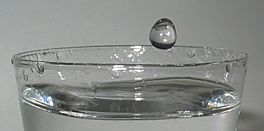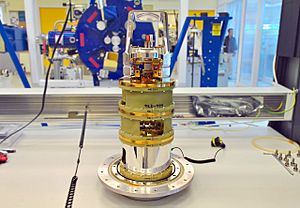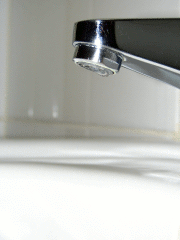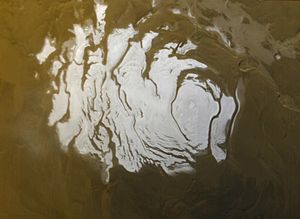Water facts for kids
Quick facts for kids Water (H2O) |
|
|---|---|
 |
|
 |
|
| IUPAC name | water, oxidane |
| Other names | Hydrogen hydroxide (HH or HOH), hydrogen oxide, dihydrogen monoxide (DHMO) (systematic name), hydrogen monoxide, dihydrogen oxide, hydric acid, hydrohydroxic acid, hydroxic acid, hydrol, μ-oxido dihydrogen, κ1-hydroxyl hydrogen(0) |
| Identifiers | |
| CAS number | |
| PubChem | |
| ChEBI | CHEBI:15377 |
| RTECS number | ZC0110000 |
| SMILES | O |
| Beilstein Reference | 3587155 |
| Gmelin Reference | 117 |
| Properties | |
| Molecular formula | |
| Molar mass | 0 g mol-1 |
| Appearance | White crystal-like solid, almost colorless liquid with a hint of blue, colorless gas |
| Odor | None |
| Density | Liquid: 0.9998396 g/mL at 0 °C 0.9970474 g/mL at 25 °C 0.961893 g/mL at 95 °C Solid: 0.9167 g/ml at 0 °C |
| Melting point | |
| Boiling point | |
| N/A | |
| Solubility | Poorly soluble in haloalkanes, aliphatic and aromatic hydrocarbons, ethers. Improved solubility in carboxylates, alcohols, ketones, amines. Miscible with methanol, ethanol, propanol, isopropanol, acetone, glycerol, 1,4-dioxane, tetrahydrofuran, sulfolane, acetaldehyde, dimethylformamide, dimethoxyethane, dimethyl sulfoxide, acetonitrile. Partially miscible with Diethyl ether, Methyl Ethyl Ketone, Dichloromethane, Ethyl Acetate, Bromine. |
| Vapor pressure | 3.1690 kilopascals or 0.031276 atm |
| Acidity (pKa) | 13.995 |
| Basicity (pKb) | 13.995 |
| Conjugate acid | Hydronium |
| Conjugate base | Hydroxide |
| Thermal conductivity | 0.6065 W/(m·K) |
| Refractive index (nD) | 1.3330 (20 °C) |
| Viscosity | 0.890 cP |
| Structure | |
| Crystal structure | Hexagonal |
| C2v | |
| Molecular shape | Bent |
| Dipole moment | 1.8546 D |
| Thermochemistry | |
| Std enthalpy of formation ΔfH |
−285.83 ± 0.04 kJ/mol |
| Standard molar entropy S |
69.95 ± 0.03 J/(mol·K) |
| Specific heat capacity, C | 75.385 ± 0.05 J/(mol·K) |
| Hazards | |
| Main hazards | Drowning Avalanche (as snow)
|
| NFPA 704 |
|
| Flash point | Non-flammable |
| Related compounds | |
| Other cations | Hydrogen sulfide Hydrogen selenide Hydrogen telluride Hydrogen polonide Hydrogen peroxide |
| Except where noted otherwise, data are given for materials in their standard state (at 25 °C, 100 kPa) | |
Water (H2O) is a transparent, tasteless, odourless, and almost colourless chemical substance and covers over 70% of Earth's surface. No known life can live without it.
Lakes, oceans, seas, and rivers are made of water. Precipitation is water that falls from clouds in the sky. It may be rain (liquid) if it is warm, or it may be frozen if it is cold. If water gets very cold (below 0 °C (32 °F)), it freezes and becomes ice, the frozen variant of water. If water gets very hot (above 100 °C (212 °F)), it boils and becomes steam or water vapor. It is moved around in the water cycle. Water is essential for life.
Contents
Physical chemistry of water
Water is a fluid. Water is the only chemical substance on Earth that exists naturally in three states. There are over 40 anomalies (strange things) about water. Unlike most other liquids such as alcohol or oil, when water freezes, it expands by about 9%. This expansion can cause pipes to break if the water inside them freezes.
Water is a molecule made of two hydrogen atoms and one oxygen atom. Its chemical formula is H2O. Like other liquids, water has a surface tension, so a little water can make drops on a surface, rather than always spreading out to wet the surface.
Things having something to do with water may have "hydro" or "aqua" in their name, such as hydropower or aquarium, from the Greek and Latin names for water. It is also called the "universal solvent", because it dissolves many other compounds.
In small amounts, water appears to have no colour but in large amounts (such as seas or lakes), it has a very light blue color.
Uses of water
Plants and animals (including people) are mostly water inside, and must drink water to live. It gives a medium for chemical reactions to take place, and is the main part of blood. It keeps the body temperature the same by sweating from the skin. Water helps blood carry nutrients from the stomach to all parts of the body to keep the body alive. Water also helps the blood carry oxygen from the lungs to the body. Saliva, which helps animals and people digest food, is mostly water. Water helps make urine. Urine helps remove bad chemicals from the body. The human body is between 60% and 70% water, but this value differs with age; i.e. a foetus is 95% water inside.
Water is the main component of drinks like milk, juice, and wine. Each type of drink also has other things that add flavor or nutrients, things like sugar, fruit, and sometimes alcohol. Water that a person can drink is called "potable water" (or "drinking water"). The water in oceans is salt water, but lakes and rivers usually have unsalted water. Only about 3% of all the water on earth is fresh water. The rest is salt water.
Many places, including cities and deserts, don't have as much water as people want. They build aqueducts to bring water there.
Though people can survive a few months without food, they can only survive for a day or two without water. A few desert animals can get enough water from their food, but the others must drink. Water has no smell, taste, or color.
Water is also used for recreational purposes, see list of water sports.
Water is used as both the coolant and the neutron moderator in most nuclear reactors. This may be ordinary water (called light water in the nuclear industry) or heavy water.
Water is also used for washing a lot of objects. Goods, services and people are transported to other countries in watercrafts on bodies of water.
Water is used in chemical reactions as a solvent or reactant. Water is also used in fire fighting. Water is also used for cooking.
Dihydrogen monoxide parody
The dihydrogen monoxide parody involves calling water by the unfamiliar chemical name "dihydrogen monoxide" (DHMO) and listing some of its harmful effects in an alarming way. Some examples include talking about how "it causes burning, suffocation and corrosion," when it is actually just talking about hot water, drowning and rust. Sometimes the parody calls for it to be banned and/or labelled as dangerous.
The prank works because it takes advantage of people's misunderstanding. Calling water by an unfamiliar name and making it sound like a harmful chemical can make people think it is dangerous.
"Dihydrogen monoxide" is an alternative chemical name for water, but nobody uses it. The word "dihydrogen" means two hydrogens, and "monoxide" means one oxygen. The chemical formula of water has two hydrogens and one oxygen.
The parody gained most of its popularity in the 1990s, when a 14-year-old named Nathan Zohner collected anti-DHMO petitions for a science project about gullibility. Zohner fooled a lot of people, which has led to his project being used in lessons about critical thinking and the scientific method.
The website DHMO.org is a joke website which lists the harmful effects of water (DHMO), answers questions, and calls for it to be banned, among other things.
Origin of the Earth's water
The weirdness of water
A BBC short item explains that every molecule on Earth has existed for billions of years, and all of them came from elsewhere. Water is alien because it arrived on asteroids and comets. It is the second most common molecule in the universe. Why is it not a gas? It is made of two very light elements. Ice floating on water is also an oddity. Also, hot water freezes faster than cold, and no-one knows why this is. Molecules of water can move up against the force of gravity (that is due to surface adhesion).
Water in the universe

Much of the universe's water is produced as a by-product of star formation. On 22 July 2011, a report described the discovery of a gigantic cloud of water vapor containing "140 trillion times more water than all of Earth's oceans combined" around a quasar located 12 billion light years from Earth. According to the researchers, the "discovery shows that water has been prevalent in the universe for nearly its entire existence".
Water has been detected in interstellar clouds in our galaxy, the Milky Way. Water probably exists in abundance in other galaxies, too. Its components, hydrogen and oxygen, are among the most abundant elements in the universe. Most other planetary systems are likely to have similar ingredients.
Origin of water on Earth: Possibilities
We do not know exactly how the Earth came to have so much water. It is everywhere in the Universe, but it is uncommon for a place to have so much. Reasoning from first principles, every element except hydrogen has been formed in stars. Therefore, oxygen was originally formed in stars. The formation of water is not a problem: it is exothermic, so forming the molecule from its atoms does not need outside energy. But to explain why the Earth has so much compared to, for example, Mars, is not easy. It is an undecided problem in planetary geology.
For a while, people thought Earth’s water did not come from the planet’s region of the protoplanetary disk. Instead, it was thought that water and other volatiles must have been delivered to Earth from the outer Solar System later in its history. But hydrogen inside the Earth did play some role in the formation of the ocean. The two ideas may each be partly right. Water was delivered to Earth by impacts from icy planetesimals (asteroids) in the outer edges of the asteroid belt. How much is not known.
Water Vapor
Water vapor is the gas form of water and is found in:
- Atmosphere of the Sun: It has small amounts of water.
- Atmosphere of Mercury: It is composed of 3.4% of water. Mercury has large amounts of water in its exosphere.
- Atmosphere of Venus: It is composed of 0.002% of water.
- Atmosphere of Earth: It is composed of 0.4% of water all over the atmosphere. There is usually around 1–4% of water at the surface of the Earth. Water vapor is also found in the extremely thin atmosphere of the Moon in small amounts.
- Atmosphere of Mars: It is composed of 0.03% of water.
- Atmosphere of Ceres.
- Atmosphere of Jupiter: It is composed of 0.0004% ice. There is also water in its moon Europa.
- Atmosphere of Saturn: It is has water in the form of ice. Enceladus is composed of 91% of ice and ice is also in Dione's exosphere.
- Atmosphere of Uranus: Ice is found in small amounts.
- Atmosphere of Neptune: Ice is also found deep in the atmosphere of Neptune.
- The atmosphere of extrasolar planets such as HD 189733 b and HD 209458 b, Tau Boötis b, HAT-P-11b, XO-1b, WASP-12b, WASP-17b, and WASP-19b.
- Stellar atmospheres: Water vapor is found in giant hot stars such as Betelgeuse, Mu Cephei, Antares and Arcturus.
Liquid Water
Liquid water is found on Earth. It covers about 71% of the surface of the Earth. Liquid water is sometimes found in small amounts on Mars. Scientists believe that liquid water is in the moons Enceladus, Titan, Europa and Ganymede.
Frozen Water
The frozen form of water (ice) is found in:
- Mars: Water ice is found at the north and south poles of Mars.
- Earth and the Moon: It is mainly found as ice sheets on Earth and in craters and volcanic rocks in the Moon.
- Ceres
- Jupiter's moons: It is found on Europa, Ganymede and Callisto.
- Saturn: It is found in the planetary rings of Saturn. It is also found in Titan and Enceladus.
- Pluto and Charon
- Comets and other objects in the Kuiper belt and Oort cloud.
Related pages
See also
 In Spanish: Agua para niños
In Spanish: Agua para niños







